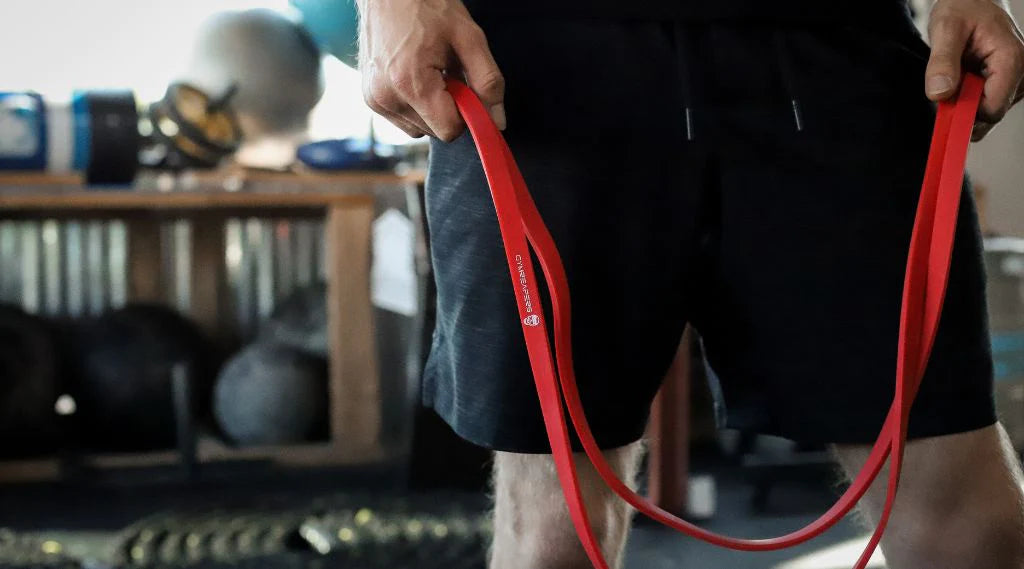If you’re interested in doing upright rows but you have limited equipment on hand, then banded upright rows are the perfect option to help you build bigger traps and shoulders.
An upright row with a band involves using the arms to pull the band from hip height to shoulder height. It is best performed with a looped band that allows you to complete each rep in one smooth motion, near the middle of your sessions, for sets of up to 15-25 slow reps.
I’ll dive into the nitty-gritty of band upright rows because knowing how to perform the exercise step by step, how to program it into your training, and what resistance bands to use will save you time and allow you to reap all the associated benefits.
Key Takeaways
Muscles Worked With Upright Rows

Upright rows are an upper-body exercise where the objective is to lift a weight from hip level to your chest in a straight line. This movement primarily trains the following muscles:
-
Shoulders: your lateral deltoids (the muscles on the side of your shoulders) play a role in arm abduction (lifting your arms away from your midline to your sides), which occurs as you pull the band from hip level to your chest.
-
Biceps: the biceps are primarily responsible for elbow flexion (bending of the arm), which is necessary for pulling the band to chest level.
-
Upper back: your trapezius, rhomboids, and other upper back muscles contribute to the rowing motion and keep the shoulder blades retracted (squeezed together) for a stronger and more stable position.
- Core: the abs, obliques, transverse abdominis, erector spinae, and glutes flex isometrically to promote full-body rigidity during upright rows.
Related Article: Back Exercises With Resistance Bands (+ Sample Workout)
How To Do Upright Rows With Bands: Step-By-Step Guide
Here are the step-by-step instructions for performing upright rows with a resistance band:
- Grab a looped resistance band of your choice. Start with a thinner band that allows you to do smooth reps through a full range of motion.
-
Step over one end of the band with both feet.
-
Hold the opposite end of the band with an overhand grip (palms facing down). Your hands should be shoulder-width apart or slightly wider and at hip level.
-
Retract your shoulder blades, squeeze your glutes, and engage your abs.
-
Inhale and pull the band from your hips to your chest in a straight line.
-
Pause briefly at the top position and slowly lower the band to your hips as you extend your arms. Exhale.
- Take another breath and repeat.
Related Articles:
- Using Bands With the Deadlift
- Resistance Band Bent Over Rows
- Pull-Ups With Resistance Bands
- Lateral Raises With Bands
- Inverted Rows With Bands
- The Banded Deadlifts
- How to Do Face Pulls With Bands
Common Banded Upright Row Mistakes
Now that you know how to perform banded upright rows, you should also be aware of the common mistakes that occur with this exercise and how to avoid them.
Mistake #1: Using a Narrow Grip
Using a close grip is one of the most common and potentially dangerous mistakes. A narrow grip places the shoulders in an unfavorable position. Having your hands closer together puts more stress on the shoulders which can cause joint discomfort and increase your risk of injury.
How to Fix
Keep your hands shoulder-width apart or slightly wider apart when gripping the resistance band. This will limit the degree of shoulder internal rotation, which reduces shoulder pinching and discomfort.
As a bonus, a wider grip leads to greater upper back and deltoid activation which can help you develop more defined upper body muscles.
Mistake #2: Using the Wrong Band
Another common mistake is using the wrong resistance band for the exercise. Oftentimes lifters try to go too heavy and choose a resistance band that is too thick.
The problem is that using too much resistance will force you to swing your body and use jerking motions to complete each repetition, robbing your muscles of the tension they need to grow.
Even if the band feels light enough at the bottom of each rep, the resistance it provides will increase as the band lengthens so it’s important to account for the change in resistance as you raise your arms.
How to Fix
Start with a lighter resistance band that allows you to perform smooth repetitions through the recommended range of motion (I’ll touch on this later on). You should also be able to execute the full range of motion for each repetition.
If you can’t pull the band all the way to your chest without “cheating the movement” then it’s too heavy and you should use a lighter band.
For instance, if you have the military band set by Gymreapers, you can start with the lightest band (20 to 35 lbs of tension) to see how it feels and if it feels too heavy, then try the next band in the set (30 to 60 lbs of tension).
Mistake #3: Lifting the Elbows Too High
Training through a full range of motion is generally better for muscle growth because you can stretch your muscles on the eccentric portion of each rep and follow up with a more intense concentric contraction.
For example, when doing bicep curls, it’s typically best to extend your arms fully on the way down (eccentric) before bending them to the point where your wrists are slightly higher than your elbows (concentric).
However, with the upright row, there is a limit to how high you should pull because lifting the elbows as high as possible could increase your risk of injury. When it comes to the upright row, more range of motion isn’t necessarily better.
“Studies indicate that impingement typically peaks between 70° and 120° of glenohumeral elevation. Authors of a 2011 paper recommend that asymptomatic individuals elevate their arms during the upright row to just below 90° (shoulder height). Other authors have made similar recommendations, so at least in this case, turn a deaf ear to the full-ROM gods.”
-Nick Tumminello, 2016 NSCA Personal Trainer of the Year and fitness expert
How to Fix
Avoid raising your elbows above shoulder level, and pay attention to how your shoulders feel. Slow down the movement by counting to 3 on the way up, pausing for 1 second, and lowering for 3 seconds.
If you’re still experiencing some pinching or general discomfort after slowing down and stopping short of shoulder height, then consider consulting a physiotherapist to help work through this limitation.
Mistake #4: Swinging Back and Forth
The final mistake with banded upright rows that you could be making is swinging your body back and forth in an effort to do more repetitions or lift your elbows higher.
The problem is that compensatory patterns can reduce muscle activation and place more stress on the joints and connective tissues. Plus, as discussed above, lifting the elbows too high could increase the risk of shoulder impingement, which is another reason to keep your reps smooth and controlled during upright rows.
How to Fix
You must maintain a stable body position and focus on using your biceps, shoulders, and upper back muscles to get the most out of upright rows. Perform your reps with control, even if that means going lighter than you want to.
Using the right muscles, rather than “cheating” will allow you to create the necessary stimulus for growth and strength gain while reducing the injury risk.
Implementing Banded Upright Rows Into Your Training Routine

One of the best ways to implement banded upright rows into your workout program is to use a lighter band and do multiple high-rep sets. You should perform each repetition slowly and with good control to engage the correct muscles and experience good muscle contractions in the top position.
You can include banded upright rows in your pull (back and biceps), push (chest, shoulders, and triceps), or general upper-body workouts.
Here is an example of how the exercise might fit into a typical workout:
|
Exercise |
Sets |
Reps |
Rest period |
|
Flat barbell bench press |
3-4 |
8-10 |
2 mins |
|
Seated dumbbell shoulder press |
3-4 |
10-12 |
2 mins |
|
Decline push-up |
3 |
RPE 8-9 |
2 mins |
|
Banded upright row |
3 |
15-25 |
1.5 mins |
|
Dumbbell lateral raise |
2-3 |
15-20 |
1-1.5 mins |
|
Cable rope tricep extensions |
2-3 |
15-20 |
1-1.5 mins |
When deciding how many sets to do, look at your training plan to determine how much extra volume you might need for your upper back, biceps, and deltoids. If you’re already doing plenty of work for these muscle groups (8-10 total sets per muscle group per workout), only add 2-3 sets of upright rows or remove an exercise for fatigue management.
The same goes for your training frequency. You can do banded upright rows 2-3 times per week but be mindful of your overall volume, training program structure, and weekly workout schedule.
For instance, if you’re following a 4-day upper/lower split, you can include a few sets of banded upright rows during both upper-body workouts.
Best Bands For Upright Rows

The military resistance band set by Gymreapers is ideal for upright rows and many other resistance exercises because these bands have a looped design and come in a variety of resistance levels to help you choose a level of resistance that suits your current abilities and to progress over time.
You can pick from several tension levels to see what matches your abilities:
- Desert Tan - 20 to 35 lbs.
- OD Green - 30 to 60 lbs.
- Dark Earth - 40 to 80 lbs.
- Ranger Green - 50 to 120 lbs.
- Coyote Brown - 60 to 150 lbs.
Finally, these bands are a great option because you can use them for many exercises, including push-ups, band-assisted pull-ups or chin-ups, bicep curls, extensions, etc. Take these bands outside and while traveling for effective full-body workouts anywhere.













Leave a comment
All comments are moderated before being published.
This site is protected by hCaptcha and the hCaptcha Privacy Policy and Terms of Service apply.